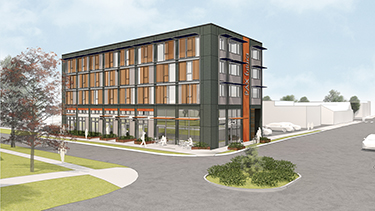|
Subscribe / Renew |
|
|
Contact Us |
|
| ► Subscribe to our Free Weekly Newsletter | |
| home | Welcome, sign in or click here to subscribe. | login |
News
| |
 |
March 23, 2017
How 'negawatts' help the building industry fight climate change
NK Architects

Semke
|
It’s clear to me that if we hope to avert catastrophic climate change we need to start viewing our buildings as clean energy power plants. As I’ll show below, it’ll be easier than you think.
Earlier this month I attended a three-day Climate Reality Leadership Corps training in Colorado led by former Vice President Al Gore. Gore and the global experts he convened for the training emphasized three things:
1. We face a climate crisis emergency.
2. We have the means to solve the crisis.
3. Cities and states need to lead climate action in the U.S. Our future depends on determined collective action now.
With reversals in U.S. climate policy underway and the Paris climate agreement in question, it’s easy to lose sight of the fact that the clean energy transition is already underway.
Falling renewable-energy costs are now challenging fossil fuels on price, without subsidy, in more regions of the world. Because clean energy is technology, not fuel, innovation drives costs down. More demand for clean energy means more deployment of clean energy, which leads to more experience and learning — further driving costs down.
This is fundamentally different from fossil fuels, which are extracted commodities. Each ton of coal is harder to reach than the last, and drives costs up.
The clean energy sector has stunned energy analysts over the past few years with faster-than-predicted uptake and cost declines. For example, the overall (levelized) cost of solar energy decreased by a staggering 85 percent over the last seven years, according to investment firm Lazard. Wind energy costs went down by 66 percent over the same period.
Likewise, the lithium ion batteries used in electric vehicles, home power storage and utility scale storage dropped by 80 percent over the past six years, according to McKinsey & Co.
This nascent clean energy transition is translating into jobs. One out of every 50 new jobs created last year in the U.S. was in the solar sector. Solar jobs in the U.S. now outnumber coal mining jobs as well as oil and gas jobs.
Generating “negawatts”
The global boom in renewable energy is reaching an important inflection point.
Renewable energy (plus some nuclear energy) made up 51 percent of the new supply of energy in 2015 globally. Many analysts, including from AllianceBernstein and U.K. research firm Trusted Sources, expect 100 percent of net new energy supply to be non-fossil fuel by 2020.
“Peak fossil fuels” may be right around the corner. That’s good news for the planet. But without a revolution in the energy consumption of our buildings, it is not enough.
The building sector is the biggest single contributor to greenhouse gas emissions in the U.S. today. We know buildings are a problem. They also can become part of the solution as a source of energy, and I’m not just talking about rooftop solar panels.
The “negawatts” we can “generate” through ultra-energy efficiency in buildings is an under-tapped energy resource. Those negawatts are especially valuable to the grid because their “production” naturally peaks during times of high demand.
So negawatts offset the energy that would otherwise be produced by carbon-intensive coal or gas “peaker” plants designed to meet that peak demand. In this way, buildings can become a form of climate action.
When we make our built environment more energy efficient, we are destroying demand for fossil fuels, and its price goes down. When fossil fuel prices go down, the more difficult-to-extract fossil fuels get stranded in the ground because they become too expensive to dig up for a low market price.
The more energy-efficient our buildings, the more fossil fuels are left stranded in the ground. Combine this with a transition to renewable energy, storage and demand response, and you’ve got the recipe for meaningful climate action.
The no-brainer choice
Architects, designers and builders have a starring role to play in climate solution-making. Architecture 2030 recognizes this, and Zero Net Carbon building design is the vehicle.
Start by creating a highly energy-efficient building to generate negawatts. Add on-site renewable energy as feasible. Finally, add locally sourced off-site renewables to reach Zero Net Carbon.
Innovation in high-performance building design is the key. If our purpose in sustainable design is to help save the planet, then we need to focus on meaningful carbon-reducing building solutions that are scalable. We do that by making our buildings so high-performing and cost-effective that the approach becomes the no-brainer choice for building owners, developers and project teams. Passive House makes this possible.
The genius of Passive House design (and other energy-efficient building approaches based on rigorous building science) is that it recognizes the building itself — its skeleton and skin — as a technology. Passive House innovation therefore improves both performance and cost, a la other clean energy technologies.
Powered by modern building science, energy modeling and an advanced analysis of the thermal properties of building structures, Passive House architecture sits squarely in the realm of information technology and science-based innovation. That is a potential game changer for the role of buildings in the clean energy transition.
Many Passive House projects today are approaching cost parity with conventional construction. When a significantly better product becomes available for little or no extra expense, then mass adoption becomes possible.
When Passive House buildings become commonplace — as they are in Europe and beginning to in Vancouver, B.C. — then the negawatts generated by this stock of ultra-efficient buildings can truly help power the grid. Future electric vehicles can be powered by these negawatts, enabling Passive House architecture to reduce emissions from both the building and the transportation sector.
Recent research by the Grantham Institute at Imperial College of London suggests that the market impact of the low and continually declining price of solar energy and electric vehicles could significantly curtail demand for fossil fuels and limit warming to between 2.4 and 2.7 degrees Celsius, when combined with strong but politically feasible climate policies. The research team concludes that decarbonization of buildings is vital to reaching the 2 degrees Celsius target.
The need to act boldly on climate solutions is urgent, given federal intransigence. Our peers in Vancouver are leading the way with their Zero Emissions Building Plan.
The city of Seattle should match that ambition and adopt Zero Net Carbon building policies aimed at making highly energy-efficient buildings scale in our city. Innovative finance structures like MEETS (metered energy efficiency transaction structure) that value building efficiency negawatts exactly like power from a power plant should be accelerated.
Now is the time to reclaim our city’s position as a beacon of sustainability. It is not hyperbole to say that our future may well depend on it.
Zack Semke is chief marketing officer at NK Architects in Seattle.
Other Stories:
- 2 state bills would reward owners who green up their buildings
- Next frontier for sustainability? The people inside all those green buildings
- 4 strategies to make office workers healthier and more productive
- ‘Biophilic’ design bonds children with nature
- Eco-friendly transfer station adds playground to be a good neighbor
- Georgia Tech wants a Living Building, but can designers beat the heat?
- Sweat the details to make building green pay off
- 12 Bel-Red townhouses help restore a trashed site



